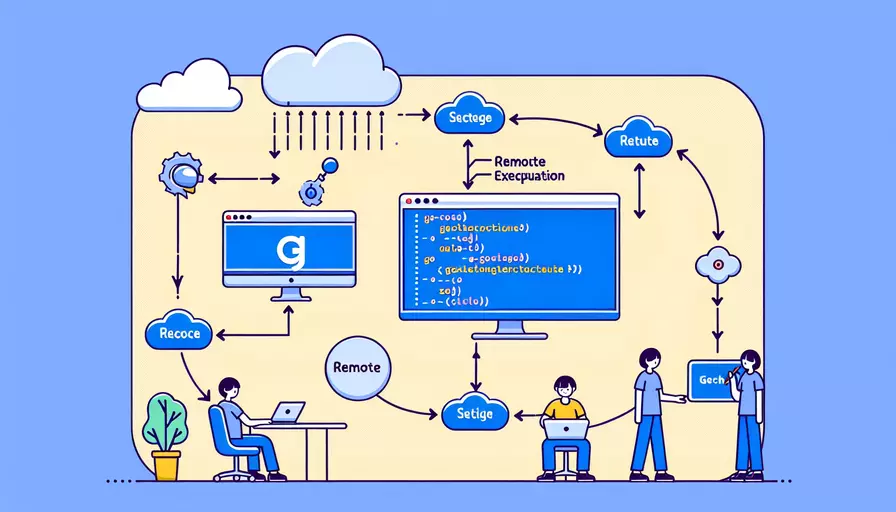go语言实现远程命令执行的方法
发布时间:2025-03-17 09:40:53 发布人:远客网络

在Go语言中,远程执行可以通过多种方式实现,1、使用SSH协议、2、使用RPC(远程过程调用)、3、使用HTTP API。本文将详细介绍这三种方法,并重点展开使用SSH协议的实现方式。
一、使用SSH协议
使用SSH协议是实现远程执行的常见方法之一。SSH(Secure Shell)是一种加密网络协议,用于在不安全的网络中安全地进行远程登录和其他安全的网络服务。以下是使用Go语言通过SSH协议进行远程执行的详细步骤:
-
安装依赖包:
go get golang.org/x/crypto/ssh -
编写代码:
package mainimport (
"fmt"
"golang.org/x/crypto/ssh"
"log"
)
func main() {
// 配置SSH客户端
config := &ssh.ClientConfig{
User: "username",
Auth: []ssh.AuthMethod{
ssh.Password("password"),
},
HostKeyCallback: ssh.InsecureIgnoreHostKey(),
}
// 连接到远程服务器
client, err := ssh.Dial("tcp", "remote.server.com:22", config)
if err != nil {
log.Fatalf("Failed to dial: %s", err)
}
defer client.Close()
// 创建一个会话
session, err := client.NewSession()
if err != nil {
log.Fatalf("Failed to create session: %s", err)
}
defer session.Close()
// 执行远程命令
var output []byte
output, err = session.CombinedOutput("uptime")
if err != nil {
log.Fatalf("Failed to execute command: %s", err)
}
fmt.Println(string(output))
}
-
解释说明:
- 连接配置:通过
ssh.ClientConfig配置SSH连接所需的用户名、密码和主机密钥回调。 - 建立连接:使用
ssh.Dial方法连接到远程服务器。 - 创建会话:通过
client.NewSession创建一个新的SSH会话。 - 执行命令:使用
session.CombinedOutput方法在远程服务器上执行命令,并获取输出。
- 连接配置:通过
二、使用RPC(远程过程调用)
RPC是一种通过网络从远程计算机程序上请求服务,而无需了解底层网络技术的通信协议。Go语言内置了对RPC的支持,可以很方便地实现远程执行。
-
编写RPC服务端代码:
package mainimport (
"net"
"net/rpc"
"net/rpc/jsonrpc"
)
type Args struct {
Command string
}
type CommandExecutor int
func (t *CommandExecutor) Execute(args *Args, reply *string) error {
// 执行命令并返回结果
*reply = "Executed: " + args.Command
return nil
}
func main() {
executor := new(CommandExecutor)
rpc.Register(executor)
listener, err := net.Listen("tcp", ":1234")
if err != nil {
panic(err)
}
for {
conn, err := listener.Accept()
if err != nil {
continue
}
go rpc.ServeCodec(jsonrpc.NewServerCodec(conn))
}
}
-
编写RPC客户端代码:
package mainimport (
"fmt"
"net"
"net/rpc/jsonrpc"
)
type Args struct {
Command string
}
func main() {
conn, err := net.Dial("tcp", "localhost:1234")
if err != nil {
panic(err)
}
client := jsonrpc.NewClient(conn)
args := Args{Command: "uptime"}
var reply string
err = client.Call("CommandExecutor.Execute", args, &reply)
if err != nil {
panic(err)
}
fmt.Println(reply)
}
-
解释说明:
- 定义服务方法:在服务端定义一个带有方法的结构体,通过注册该结构体使其成为RPC服务。
- 监听连接:在服务端监听特定端口,接受客户端连接并处理请求。
- 客户端调用:在客户端通过
net.Dial连接服务端,并使用client.Call方法远程调用服务端的方法。
三、使用HTTP API
HTTP API是一种通过HTTP协议进行远程调用的方式。它通常用于构建RESTful服务,通过HTTP请求执行远程操作。
-
编写HTTP服务端代码:
package mainimport (
"encoding/json"
"net/http"
)
type CommandRequest struct {
Command string `json:"command"`
}
type CommandResponse struct {
Output string `json:"output"`
}
func executeHandler(w http.ResponseWriter, r *http.Request) {
var req CommandRequest
json.NewDecoder(r.Body).Decode(&req)
// 执行命令
output := "Executed: " + req.Command
res := CommandResponse{Output: output}
json.NewEncoder(w).Encode(res)
}
func main() {
http.HandleFunc("/execute", executeHandler)
http.ListenAndServe(":8080", nil)
}
-
编写HTTP客户端代码:
package mainimport (
"bytes"
"encoding/json"
"fmt"
"net/http"
)
type CommandRequest struct {
Command string `json:"command"`
}
type CommandResponse struct {
Output string `json:"output"`
}
func main() {
req := CommandRequest{Command: "uptime"}
reqBody, _ := json.Marshal(req)
resp, err := http.Post("http://localhost:8080/execute", "application/json", bytes.NewBuffer(reqBody))
if err != nil {
panic(err)
}
defer resp.Body.Close()
var res CommandResponse
json.NewDecoder(resp.Body).Decode(&res)
fmt.Println(res.Output)
}
-
解释说明:
- 定义HTTP处理函数:在服务端定义一个处理特定HTTP请求的函数,通过
http.HandleFunc注册该函数。 - 解析请求和响应:在处理函数中解析客户端请求的JSON数据,并执行相应的操作后返回结果。
- 客户端请求:在客户端使用
http.Post发送HTTP请求,并解析服务端返回的JSON响应。
- 定义HTTP处理函数:在服务端定义一个处理特定HTTP请求的函数,通过
总结与建议
通过上述三种方法,可以在Go语言中实现远程执行。各方法各有优劣,具体选择取决于应用场景和需求。使用SSH协议适用于需要安全连接和执行系统命令的场景;RPC适合需要高效通信和复杂操作的场景;HTTP API则适合构建RESTful服务,便于与其他系统集成。
建议根据具体需求选择适当的方法,并确保在实现过程中考虑安全性和性能优化。熟悉Go语言的并发处理机制,可以进一步提升远程执行的效率和可靠性。
更多问答FAQs:
1. 远程执行指什么?
远程执行是指在一个计算机上执行的操作可以通过网络连接到另一个计算机上进行执行。对于Go语言而言,远程执行可以是将Go程序部署到远程服务器上并在远程服务器上运行。
2. 如何使用Go语言进行远程执行?
要使用Go语言进行远程执行,可以使用Go标准库中的net包和os/exec包。您需要建立与远程服务器的网络连接,可以使用net.Dial()函数或者net.DialTimeout()函数来建立TCP连接或者UDP连接。您可以使用os/exec包中的Command()函数来创建一个命令对象,并通过Command对象的方法来设置要在远程服务器上执行的命令和参数。最后,使用Command对象的Run()方法来执行命令。执行结果可以通过Command对象的Output()方法或者CombinedOutput()方法获取。
3. 远程执行有哪些应用场景?
远程执行在实际开发中有广泛的应用场景。例如,当您需要将一个Go程序部署到多台远程服务器上并在这些服务器上同时运行时,可以使用远程执行来实现。远程执行还可以用于远程服务器的维护和管理,例如在远程服务器上执行一些系统命令来查看服务器的状态、管理进程等。远程执行还可以用于构建分布式应用程序,例如将一个Go程序拆分成多个模块,在不同的远程服务器上运行这些模块,并通过网络连接来协调它们的工作。远程执行为开发人员提供了更多灵活的方式来管理和运行程序。










